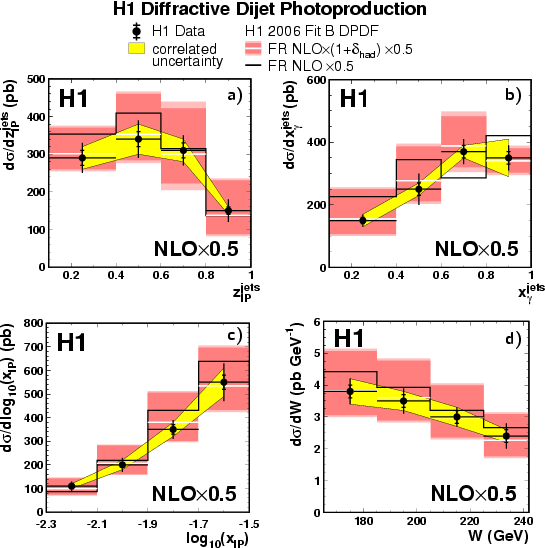Tests of QCD Factorisation in the Diffractive Production of Dijets in Deep-Inelastic Scattering and Photoproduction at HERA
Diffractive scattering is studied in positron-proton collisions in which the proton
stays intact (or dissociates into a system of mass <1.6 GeV)
and loses less than 3% of its initial beam energy.
Rapidity gap events are selected in which the detector is empty in a region corresponding to 3 to 4 units in
pseudorapidity measured from the direction of the outgoing proton system.
The events are required to contain two jets of 5 and 4 GeV minimal transverse energy.
The analysis is performed in two kinematic ranges which differ in the negative photon virtuality Q2:
- deep-inelastic scattering (DIS, 4<Q2<80 GeV2): The photon behaves essentially
like a point-like particle without internal structure.
- photoproduction (Q2<0.01 GeV2: The photon can fluctuate into a hadronic system of
which one parton with photon momentum fraction xgamma enters the hard scatter which produces the jets.
An energetic photon remnant system is present in events with low xgamma.
Does this photon remnant take part in additional interactions in the event which spoil the gap? (find the answer below)
Dijet production cross sections are measured and compared to next-to-leading order perturbative QCD calculations which are based on
the diffractive proton structure (quark and gluon momentum densities) extracted in inclusive diffractive DIS
("inclusive": no dijet or other requirement on the hadronic final state was imposed).
The calculations describe diffractive dijet production in DIS well within experimental and theoretical uncertainties.
In diffractive DIS, dijet production and inclusive scattering are described using the same proton structure
(QCD factorisation).
QCD factorisation breaks down in photoproduction where the prediction has to be suppressed by a factor
of approximately 0.5 to describe the measurement.
The ratio of dijet measurement to NLO prediction in photoproduction is a factor 0.5+-0.1 smaller than the same
ratio in DIS.
No dependence of the suppression on xgamma was found, so the photon remnant does not seem to
be the reason for the suppression.

Dijet cross sections in photoproduction as a function of a) the fractional momentum of the parton from the diffractive
exchange, b) xgamma, c) the fractional proton momentum xIP carried across the gap, and
d) the photon-proton centre-of-mass energy. The NLO QCD calculation has been scaled down by a factor of 0.5.
An alternative approach to diffraction are soft colour neutralisation models. In these models, diffraction occurs
through colour reconfiguration in the final state. Two leading order QCD models (supplemented by parton showers)
are tested, which were tuned to inclusive diffractive DIS.
The SCI model describes diffractive dijet production reasonably well in DIS but not in photoproduction.
The GAL model fails in both kinematic regions.
Last modified: Wed Apr 4 15:08:02 2007 MET
